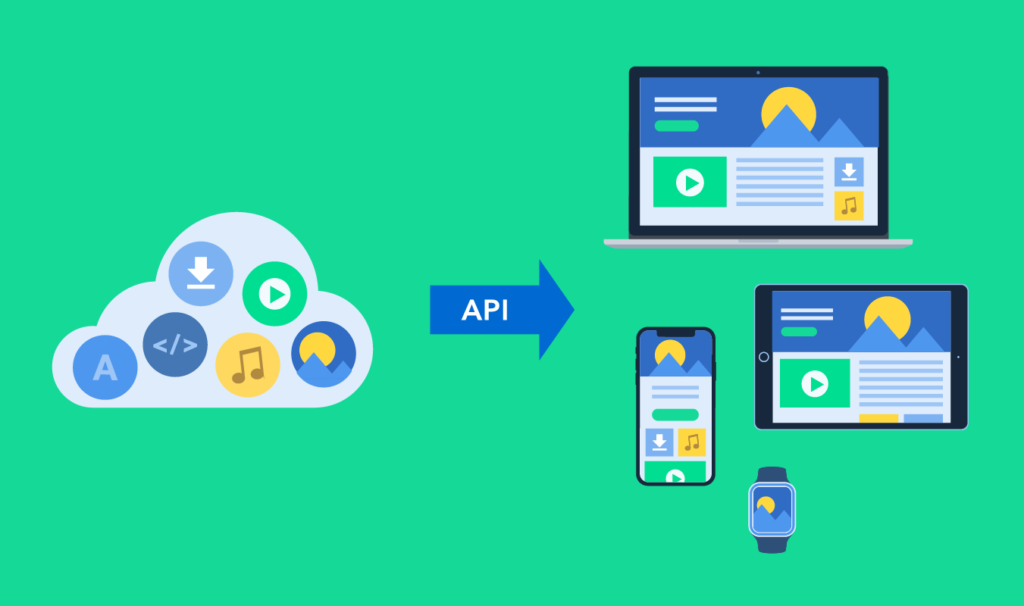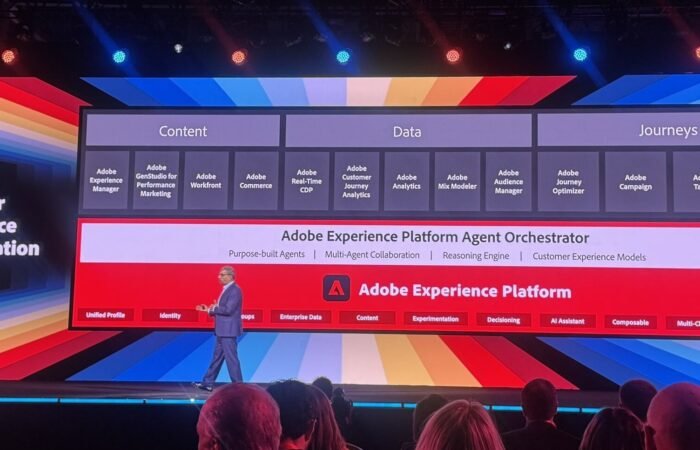Content as a Service (CaaS) offers a progressive and innovative way to manage and deliver content.
Today’s companies are tasked with the challenge of delivering consistent, value-add content to their audiences to remain relevant, competitive, and drive growth. This task becomes even more complex as companies expand their reach and strive to connect with a diverse, global audience. Traditional methods of content management and delivery can be limiting, making it difficult for companies to keep pace with demand.
This is where Content as a Service comes in.
What is Content as a Service?
Content as a Service is a type of cloud service model that enables businesses to deliver content flexibly over the internet. The goal of CaaS is to make it easier to manage, store, and share content.
Content as a Service is where a provider delivers on-demand content to consumers.
Contentful
CaaS allows businesses to access content faster than traditional methods because the data is stored in the cloud and can be accessed anywhere. With Content as a Serivce, businesses can increase storage capacity, bandwidth, and speed on demand rather than having to purchase additional hardware or software upfront. This makes it easier for brands to stay ahead of customer needs and provide them with timely updates and new features.
Within the Content as a Service space, one company stands out as a leader: Contentful. Why? Here are just a few reasons:
Contentful Features
Flexible and Scalable Architecture
First and foremost, Contentful is API-based. Having a flexible, API-first architecture is a software development approach that focuses on creating intuitive application programming interfaces (APIs) as the primary building blocks of an application. This allows developers to quickly develop applications that are tailored to their specific needs and use cases. Furthermore, it enables them to build applications without having to worry about the underlying infrastructure and technology stacks they are using. This type of architecture is designed to be extremely adaptable, allowing developers to easily integrate new features and technologies into their existing applications.
With an API-first approach, marketeers can leverage the platform’s APIs to quickly and seamlessly connect with other systems, such as CRMs, analytics, and customer service tools enabling them to automate processes, such as lead capture and data transfer. This automates the manual work with streamlined workflows, freeing up time and resources for more strategic initiatives.
All of this allows companies to easily manage, deliver and measure the impact of their content across multiple channels and platforms. CaaS platforms are designed to scale with growing businesses, allowing international enterprises to easily manage and deliver content to a large and diverse global audience.

Streamlined Change Management
Contentful’s webhooks are incredibly valuable when it comes to content as a service. This is where you’re thinking … but what are webhooks? Webhooks provide the ability to automatically trigger events when data within an organization has changed.
If a user adds or changes content within the CMS, Contentful’s webhooks immediately notify other departments or services of this change, allowing them to quickly act on it and ensuring that content is up-to-date and accurate across all platforms. This is invaluable for organizations who need to ensure their data is up-to-date across multiple platforms without having to manually check every system each time there is a change.
For example, let’s consider a multilingual company with websites all over the world. When a change is made to a piece of content, the webhook can instantly trigger an event to check if the translation is correct. If it’s not, the webhook can then send an alert to the necessary teams, allowing them to quickly address the issue and make the necessary corrections before going live.
In a global company with multilingual needs, translation accuracy is crucial, as even small errors can have significant consequences such as causing confusion, offending target audiences, or damaging the company’s reputation.
Centralized Content Management
Like I said earlier, the whole goal with CaaS is ultimately great content management, right?
Contentful provides a powerful, intuitive content management system that makes it easy for teams to create, manage, and publish all types of content – be it text, images, videos, etc. – across various digital channels.
With features like version control, role-based access controls, and real-time collaboration, Contentful streamlines the content creation process and ensures that teams can work together effectively. By having all content stored in one place, this allows multiple users to access it simultaneously giving employees a single source of truth when collaborating with each other. This makes working together on projects so much easier when teams don’t have to worry about finding the correct version or document from multiple sources.
For global, multi-language enterprises the ability to centralize content management operations makes it simpler to manage and distribute content across multiple regions, languages, and time zones. This eliminates the need for separate, regional content management systems, streamlining the content creation process.
Flexible Content Modeling
Contentful’s highly flexible content modeling capabilities enable enterprises to build their content structure in a manner that is tailored for their own particular requirements, while also making sure to stay aligned with their own content strategy.
Contentful is easy to use and incredibly powerful. The flexibility and scalability make it easy to customize any content model to fit the specific needs of a project.
Dave Whiting, Content Bloom
With custom schemas and data models, users have far greater control over organizing and managing their digital assets. It gives them a more comprehensive understanding of the content they are dealing with, allowing them to tailor the way it is used across relevant channels and platforms. This makes sure that the right content can be delivered to the right place at the right time, helping to inspire engagement and conversions.
Omnichannel Delivery
Every modern marketer will tell you that omnichannel delivery is a non-negotiable right now. For companies that are interested in increasing customer engagement and making their products or services more accessible to customers, it is vital to have a good omnichannel delivery system in place.
When businesses can consistently provide customers with personalized content across multiple channels, they can build trust and loyalty better than ever before. And to do that, companies must ensure that the same content, assets, and campaigns are consistently available to customers regardless of the channel they’re using. This helps them create a unified experience for customers where their interactions with the company feel seamless no matter what platform they are interacting with. In this way, companies can utilize cross-channel marketing tactics more effectively and increase engagement across platforms even further.
Businesses also benefit from the ability to track and monitor how users interact with their products or services through different channels. This gives them valuable insights into how users consume content across devices, giving them insight into areas where they need to improve their user experience or product offerings.
Learn more about How Contentful is Boosting Omnichannel CX to the Next Level.
Strong Integration Ecosystem
Contentful’s strong integration ecosystem is one of its top differentiators in the Content as a Service (CaaS) space. By integrating with a wide range of tools and technologies, including other popular content management systems, ecommerce platforms, and marketing automation tools, enterprises gain the ability to streamline their processes and improve operational efficiency.
This integration ability eliminates the need for manual data transfer and reduces the risk of errors and discrepancies. A seamless integration of Contentful with other tools enables enterprises to manage their content alongside other critical business processes, freeing up resources and allowing them to focus on more strategic initiatives.
Some examples of where this can really shine?
- Ecommerce retailers: For those looking to perfect the modern ecommerce experience, the integration with platforms such as Shopify and Magento provides a unified view of their content and commerce data, making it easier to manage their products, categories, and customer information. This leads to higher levels of customer satisfaction as well as a streamlined, efficient platform by which to manage transactions and data analysis.
- Content teams: Content managers are often responsible for creating and editing large amounts of content on a regular basis, which can be time-consuming and complex. To make content creation and editing easier, custom editors can be developed to provide tailored functionality that is tailored to specific user groups. For example, custom editors can be used to simplify the data entry process by allowing users to enter data into intuitive fields or using drop-down menus. These custom editors can integrate with external systems to automatically pull in relevant data or pre-populate fields so that users do not have to manually enter information each time they create or edit content. This not only simplifies the process but helps reduce errors due to incorrect data entry.
- Acquisitive companies: Highly acquisitive companies need an extra level of flexibility to ensure that their business operations remain as efficient and effective as possible. A heavy-duty integration ecosystem is a key factor in this regard, allowing companies to bring multiple brands (and their respective tech stacks) into the fold without compromising performance.
Learn more about how we’ve handled highly acquisitive companies looking to incorporate new brands in System Migration for Enterprise Acquisitions.
Robust Security and Compliance
With any content platform, security and compliance are critical in CaaS for several reasons.
- Data Privacy: With the increasing amount of sensitive and critical data being stored and processed, it is important to ensure that this data is protected from unauthorized access or theft.
- Regulations: There are various data privacy regulations, such as the EU’s General Data Protection Regulation (GDPR) and the California Consumer Privacy Act (CCPA), that require companies to protect the personal data of their customers and users.
- Trust: In order for companies to trust CaaS platforms to manage and deliver their content, it is important for these platforms to provide strong security and compliance measures to protect the data and information being stored.
- Business Continuity: In the event of a security incident or disaster, robust security and compliance measures ensure that data is protected and business can continue without interruption.
- Reputation: Companies have a responsibility to protect the sensitive and critical data of their customers and users, and failing to do so can have serious consequences for their reputation and credibility.
Contentful and Content as a Service
I believe that Content as a Service will only continue to become an increasingly important tool for businesses looking to stay relevant in the digital age.
Contentful CMS offers a comprehensive set of features and capabilities that make it stand out among many in the space. The flexible and scalable architecture, change management, centralized content management, flexible content modeling, and omnichannel delivery can be powerful tools when used correctly. Further, the strong integration ecosystem ensures secure transactions are done with robust security and compliance protocols.
Taking all these features into account, it’s clear that Contentful is a key player in today and tomorrow’s digital race.
To learn more about our range of services as a Contentful partner, reach out.
FAQ
1. What is Contentful CMS?
2. What makes Contentful a great choice for content management?
- User-friendly features and interface, making it easy to use for developers and non-developers alike.
- Improved agility and scalability with an API-driven approach.
- Comprehensive security with multiple authentication methods, encryption of data in transit, and authorization controls coded into the platform.
- Flexible platform that supports a wide range of rich media types, allowing users to create dynamic experiences across devices.
- Support for third-party services so enterprises can integrate their new and existing systems seamlessly into the Contentful CMS.
- Easy internationalization with built-in localization features.
3. What are the business benefits of Content as a Service?
- Cost savings are achieved by eliminating the need for purchasing hardware components or managing infrastructure costs.
- Increased agility enables faster processing speeds and better resource allocation through cloud-based systems.
- Improved user experience thanks to reliable access to content on any device at any time with minimal latency or buffering times.





